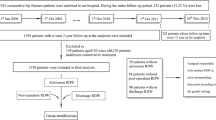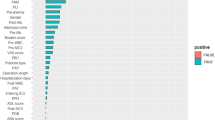Abstract
Summary
The prognostic value of red cell distribution width (RDW) and a combination of RDW and the American Society of Anesthesiologists (ASA) score for long-term hip fracture mortality remains unknown. Our data showed that both RDW and ASA were independent risk predictors. A combination of these two parameters may provide a more powerful strategy for the prediction of hip fracture mortality.
Introduction
Red cell distribution width (RDW) has recently been suggested as an independent predictor of prognosis in a variety of disorders. The American Society of Anesthesiologists (ASA) system has been widely used to stratify patients for outcome evaluations. However, the prognostic value of RDW and a combination of RDW and the ASA score for long-term hip fracture mortality has yet to be studied.
Methods
This prospective cohort study included 1402 subjects from 2000 to 2011 with a follow-up study over a 2 year period. Cox proportional hazards models with a bootstrap validation were used to evaluate associations of RDW, ASA, and a combination of both with long-term mortality. The global fit and the area under the receiver operating characteristic (ROC) curve (AUC) for model discrimination were further analyzed.
Results
Both RDW and ASA exhibited as independent risk predictors of 2-year mortality. The population with elevation of either RDW or ASA increased the risk of mortality (bootstrap validated hazard ratio (HR) 1.971 95 % confidence interval (CI) [1.336–3.005] p < 0.01) while those with an increase in both assessments (bootstrap validated HR 2.667 95 % CI [1.526–4.515] p < 0.01) were at the highest risk for mortality. The addition of the combination of ASA and RDW improved the discrimination power of risk prediction models (AUC increased from 0.700 to 0.723, p < 0.05).
Conclusion
Both RDW and ASA exhibited as independent risk predictors of 2-year hip fracture mortality. The combination of these two readily available parameters may provide a more powerful and effective strategy for the assessment of all-cause mortality in hip fracture patients.



Similar content being viewed by others
References
Abrahamsen B, van Staa T, Ariely R et al (2009) Excess mortality following hip fracture: a systematic epidemiological review. Osteoporos Int: J Establ Result Coop Eur Found Osteoporos Natl Osteoporos Found USA 20:1633–1650
Tosteson AN, Melton LJ 3rd, Dawson-Hughes B et al (2008) Cost-effective osteoporosis treatment thresholds: the United States perspective. Osteoporos Int: J Establ Result Coop Eur Found Osteoporos Natl Osteoporos Found USA 19:437–447
Omsland TK, Emaus N, Tell GS et al (2014) Mortality following the first hip fracture in Norwegian women and men (1999-2008). A NOREPOS study. Bone 63:81–86
Klop C, Welsing PM, Cooper C et al (2014) Mortality in British hip fracture patients, 2000-2010: a population-based retrospective cohort study. Bone 66:171–177
Charlson ME, Pompei P, Ales KL et al (1987) A new method of classifying prognostic comorbidity in longitudinal studies: development and validation. J Chronic Dis 40:373–383
Mohamed K, Copeland GP, Boot DA et al (2002) An assessment of the POSSUM system in orthopaedic surgery. J Bone Joint Surg (Br) 84:735–739
Jiang HX, Majumdar SR, Dick DA et al (2005) Development and initial validation of a risk score for predicting in-hospital and 1-year mortality in patients with hip fractures. J Bone Miner Res: Off J Am Soc Bone Miner Res 20:494–500
Michel JP, Klopfenstein C, Hoffmeyer P et al (2002) Hip fracture surgery: is the pre-operative American Society of Anesthesiologists (ASA) score a predictor of functional outcome? Aging Clin Exp Res 14:389–394
van Zeeland ML, Genovesi IP, Mulder JW et al (2011) POSSUM predicts hospital mortality and long-term survival in patients with hip fractures. J Trauma 70:E67–72
Rushton PR, Reed MR, Pratt RK (2015) Independent validation of the Nottingham Hip Fracture Score and identification of regional variation in patient risk within England. Bone Joint J 97-b:100–103
Pugely AJ, Martin CT, Gao Y et al (2014) A risk calculator for short-term morbidity and mortality after hip fracture surgery. J Orthop Trauma 28:63–69
Moppett IK, Parker M, Griffiths R et al (2012) Nottingham Hip Fracture Score: longitudinal and multi-assessment. Br J Anaesth 109:546–550
Copeland GP, Jones D, Walters M (1991) POSSUM: a scoring system for surgical audit. Br J Surg 78:355–360
Magi E (1997) ASA classification and perioperative variables as predictors of postoperative outcome. Br J Anaesth 78:228
Owens WD, Felts JA, Spitznagel EL Jr (1978) ASA physical status classifications: a study of consistency of ratings. Anesthesiology 49:239–243
Hamlet WP, Lieberman JR, Freedman EL et al (1997) Influence of health status and the timing of surgery on mortality in hip fracture patients. Am J orthop (Belle Mead NJ) 26:621–627
Koval KJ, Skovron ML, Aharonoff GB, et al (1995) Ambulatory ability after hip fracture. A prospective study in geriatric patients. Clin Orthop Relat Res 150-159
Liu Y, Peng M, Lin L, et al (2014) Relationship between American Society of Anesthesiologists (ASA) grade and 1-year mortality in nonagenarians undergoing hip fracture surgery. Osteoporos Int: J Establ Result Coop Eur Found Osteoporos Natl Osteoporos Found USA
Holt G, Smith R, Duncan K et al (2008) Early mortality after surgical fixation of hip fractures in the elderly: an analysis of data from the scottish hip fracture audit. J Bone Joint Surg Br 90:1357–1363
Salvagno GL, Sanchis-Gomar F, Picanza A, et al (2014) Red blood cell distribution width: a simple parameter with multiple clinical applications. Crit Rev Clin Lab Sci 1-20
Nathan SD, Reffett T, Brown AW et al (2013) The red cell distribution width as a prognostic indicator in idiopathic pulmonary fibrosis. Chest 143:1692–1698
Borne Y, Smith JG, Melander O et al (2014) Red cell distribution width in relation to incidence of coronary events and case fatality rates: a population-based cohort study. Heart 100:1119–1124
Seretis C, Seretis F, Lagoudianakis E et al (2013) Is red cell distribution width a novel biomarker of breast cancer activity? Data from a pilot study. J Clin Med Res 5:121–126
Kurt YG, Cayci T, Aydin FN et al (2014) Is red cell distribution width a useful biomarker for risk assessment of diabetes mellitus? J Intern Med 276:537
Yao J, Lv G (2014) Association between red cell distribution width and acute pancreatitis: a cross-sectional study. BMJ Open 4:e004721
Ilhan E, Guvenc TS, Altay S et al (2012) Predictive value of red cell distribution width in intrahospital mortality and postintervention thrombolysis in myocardial infarction flow in patients with acute anterior myocardial infarction. Coron Artery Dis 23:450–454
Su C, Liao LZ, Song Y et al (2014) The role of red blood cell distribution width in mortality and cardiovascular risk among patients with coronary artery diseases: a systematic review and meta-analysis. J Thoracic Dis 6:1429–1440
Poludasu S, Marmur JD, Weedon J et al (2009) Red cell distribution width (RDW) as a predictor of long-term mortality in patients undergoing percutaneous coronary intervention. Thromb Haemost 102:581–587
Nunez J, Nunez E, Rizopoulos D et al (2014) Red blood cell distribution width is longitudinally associated with mortality and anemia in heart failure patients. Circ J: Off J Jpn Circ Soc 78:410–418
Zorlu A, Bektasoglu G, Guven FM et al (2012) Usefulness of admission red cell distribution width as a predictor of early mortality in patients with acute pulmonary embolism. Am J Cardiol 109:128–134
Wang YL, Hua Q, Bai CR et al (2011) Relationship between red cell distribution width and short-term outcomes in acute coronary syndrome in a Chinese population. Intern Med 50:2941–2945
Tonelli M, Sacks F, Arnold M et al (2008) Relation between red blood cell distribution width and cardiovascular event rate in people with coronary disease. Circulation 117:163–168
Garbharran U, Chinthapalli S, Hopper I et al (2013) Red cell distribution width is an independent predictor of mortality in hip fracture. Age Ageing 42:258–261
Cosman F, de Beur SJ, LeBoff MS et al (2014) Clinician's guide to prevention and treatment of osteoporosis. Osteoporos Int: J Establ Result Coop Eur Found Osteoporos Natl Osteoporos Found USA 25:2359–2381
Altman DG, Royston P (2000) What do we mean by validating a prognostic model? Stat Med 19:453–473
Friedman JS, Lopez MF, Fleming MD et al (2004) SOD2-deficiency anemia: protein oxidation and altered protein expression reveal targets of damage, stress response, and antioxidant responsiveness. Blood 104:2565–2573
Semba RD, Patel KV, Ferrucci L et al (2010) Serum antioxidants and inflammation predict red cell distribution width in older women: the Women's Health and Aging Study I. Clin Nutrition (Edinb) 29:600–604
Jelkmann W (1998) Proinflammatory cytokines lowering erythropoietin production. J Interf Cytokine Res: Off J Int Soc Interf Cytokine Res 18:555–559
Zehir S, Sipahioglu S, Ozdemir G et al (2014) Red cell distribution width and mortality in patients with hip fracture treated with partial prosthesis. Acta Orthop Traumatol Turc 48:141–146
Bretherton CP, Parker MJ (2015) Early surgery for patients with a fracture of the hip decreases 30-day mortality. Bone Joint J 97-b:104–108
Ooi LH, Wong TH, Toh CL et al (2005) Hip fractures in nonagenarians–a study on operative and non-operative management. Injury 36:142–147
Tay YW, Hong CC, Murphy D (2014) Functional outcome and mortality in nonagenarians following hip fracture surgery. Arch Orthop Trauma Surg 134:765–772
Haynes SR, Lawler PG (1995) An assessment of the consistency of ASA physical status classification allocation. Anaesthesia 50:195–199
Acknowledgments
This work was supported by grants from the National Natural Science Foundation of China (NSFC) (31370947, 81401809). The funders had no role in study design, data collection and analysis, decision to publish, or preparation of the manuscript.
Author information
Authors and Affiliations
Corresponding authors
Ethics declarations
The research protocol was approved by the medical ethics committee of PLA general hospital.
Conflicts of interest
None.
Additional information
P. Yin and H. Lv contributed equally to this work.
Appendices
Fig. A1
Survival curve for combination of RDW and ASA (stratified in four groups). (GIF 11 kb)
Table A1
Detailed results of multivariate Cox proportional hazards analysis for RDW. (PDF 59 kb)
Table A2
Detailed results of multivariate Cox proportional hazards analysis for ASA score. (PDF 127 kb)
Table A3
Detailed results of multivariate Cox proportional hazards analysis for the combination of RDW and ASA. (PDF 110 kb)
Rights and permissions
About this article
Cite this article
Yin, P., Lv, H., Zhang, L. et al. Combination of red cell distribution width and American Society of Anesthesiologists score for hip fracture mortality prediction. Osteoporos Int 27, 2077–2087 (2016). https://doi.org/10.1007/s00198-015-3357-x
Received:
Accepted:
Published:
Issue Date:
DOI: https://doi.org/10.1007/s00198-015-3357-x




